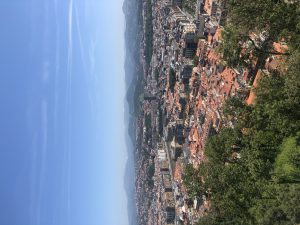As we walk up Mount Urgull, San Sebastián appears to get smaller and smaller. From the top of the mountain it’s hard to see past the beautiful coast line and antique homes and remember the troubling times of the past. The Basque Country has undergone a lot of conflicts to get to where they are today. They found themselves the victim of the Spanish Civil War after refusing to take sides. Being Basque is different than being Spanish. They did not see this war as anything of their concern. The Spanish Civil War was between the Spanish, and the Basques considered themselves as having little part in those affairs. Basques have a separate culture and a distinct language. And as we read in one of our assigned books, people who move to the Basque region tend not feel completely welcomed even after numerous years of living there because of the close knit community. This was the case with Joni in the novel All That Followed by Gabriel Urza. He moved from America to near San Sebastián and despite after living there for twenty years, he still did not feel at home in the Basque region. This comes in part from the 19th Century when individuals are only seen and accepted as Basque if they possess eight Basque last names from their ancestors. Since Joni was an outsider and did not possess these last names he was not treated as an important part of the community. Another interesting feature is that around here the friends you have as a child are the friends you have for life. This is known as a cuadrilla. Here, you remain a part of your cuadrilla long after you have grown up and moved far away. Additionally, it is not uncommon to stay with one’s high school or even middle school sweetheart. While many Basques choose to get married, a good amount decide not to get married as it is seen as a religious convention that, especially outside the cities, they hold less and less as part of their identity.
The Basque people are thought to be the first ethnic group in Europe. The borders have moved around them, but they’ve remained in this region for thousands of years, which accounts for part of the reason they see themselves as separate from the Spanish, who came later. After refusing to take sides in the Spanish Civil War, the democratic Spanish government offered them greater autonomy if they chose to fight alongside the government for the sake of democracy against the military coup, which was backed by other fascist powers in Europe. Democracy, however, lost, and when General Franco became dictator of Spain, he suppressed the Basque language and culture. Having always seen themselves as independent, they were determined to bring back their way of life and to fight against this cultural oppression. Hence, ETA, the Basque terrorist group, was born. As a result, violence continued throughout this region.
A key part of Basque identity and culture is language. The language of Basque is complex and not related to Spanish or another Romance language making it very difficult to learn. In All That Followed, the new English teacher’s wife only spoke English. She was labeled as an outsider and failed to meet new people as a result. After Franco’s rule, the number of Basque speakers started to increase. The division between Basque and Spanish speakers in the Basque region has prompted the use of both languages displayed on road signs and in restaurants. Spanish restaurants and bars have pinchos while Basque restaurants and bars have pinxtos. Pinxtos are never free whereas tapas and pinchos in the Spanish region can be. Pintxo Pote was created after The Recession stole many people’s jobs and left them with no money. Pintxo Pote is one night a week in a neighborhood here where one can buy a pintxo and drink for two euros at participating restaurants and bars. The purpose was to allow for the community to stay close and active with one another because many of them could no longer afford to eat or drink out and socialize with other members of the community as they once had. This weekly tradition was so popular that it has continued long after the aftermath of The Recession. Pinxtos can range from tortilla to prones or chorizo to ham filled croissants. Each restaurant carries a different variety of pinxtos, with the same pintxo from different places never tasting quite the same. Some places are known for their ugly tomato while others are known for their blood sausage. Bread is typically served with each pinxto at all bars, and restaurants and can be seen at any meal throughout the day. Walking back down the mountain it is easy to depict the similarities in each house. San Sebastián has managed to preserve its old cultural roots, Basque language, and house foundation.

